Situation
I am working on an application where I can have a grid with X items, and each item has a print button. Clicking this print button allows me to call an ajax function which passes the ID of the grid item to a controller. I retrieve the relevant data based on that ID and then download it in an excel file. (The retrieving of the specific item is not yet done)
What I have so far
So far, I have the basic code that downloads an excel file, along with my grid .
Problem
The problem I am facing is, if I click the "Print" button...nothing happens, even with a breakpoint in my exporttoexcel functions shows me that the function is entered and I can step thru it and despite no errors, nothing occurs. However, I added random button that called the same function and when i clicked that button, the excel file was downloaded. As a result, I believe the issue has something to do with aJax.
Code
<input type="button" value="Test" onclick="location.href='@Url.Action("ExportToExcel", "Profile")'" />
This is the code which downloads the file. It was a simple button I added.
function ExportToExcel(id) {
$.ajax({
type: "POST",
url: "@Url.Action("ExportToExcel", "Profile")",
data: { "id": id },
dataType: "json"
});
}
This is the function that I want to work, but it does not work and I cannot see what i've got wrong.
Export to Excel Code
public void ExportToExcelx()
{
var products = new System.Data.DataTable("teste");
products.Columns.Add("col1", typeof(int));
products.Columns.Add("col2", typeof(string));
products.Rows.Add(1, "product 1");
products.Rows.Add(2, "product 2");
products.Rows.Add(3, "product 3");
products.Rows.Add(4, "product 4");
products.Rows.Add(5, "product 5");
products.Rows.Add(6, "product 6");
products.Rows.Add(7, "product 7");
var grid = new GridView();
grid.DataSource = products;
grid.DataBind();
Response.ClearContent();
Response.Buffer = true;
Response.AddHeader("content-disposition", "attachment; filename=MyExcelFile.xls");
Response.ContentType = "application/ms-excel";
Response.Charset = "";
StringWriter sw = new StringWriter();
HtmlTextWriter htw = new HtmlTextWriter(sw);
grid.RenderControl(htw);
//Response.Output.Write(sw.ToString());
//Response.Flush();
//Response.End();
// =============
//Open a memory stream that you can use to write back to the response
byte[] byteArray = Encoding.ASCII.GetBytes(sw.ToString());
MemoryStream s = new MemoryStream(byteArray);
StreamReader sr = new StreamReader(s, Encoding.ASCII);
//Write the stream back to the response
Response.Write(sr.ReadToEnd());
Response.End();
// return View("MyView");
}
Theory
I believe the error is somehow tied in to aJax, I am also creating the button in the controller like this.
"<button type='button' class='btn btn-warning' onclick='ExportToExcel(" + c.id + ");'>Print</button>",
Since location.href='@Url.Action works, I was wondering if attempting to redo my dynamic button would solve my issue.
Appreciate any insight that could be offered.
